Buying into Feminism: When Fashion Designers Sell Politics Alongside Their Clothes
The line between making genuine political statements and cashing in on the resistance has become murky. We look at the designers who are getting it right
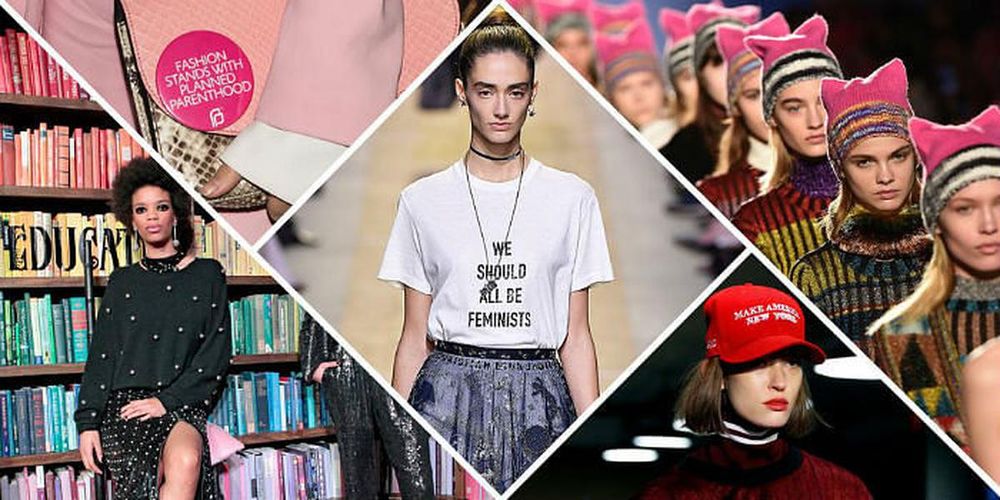
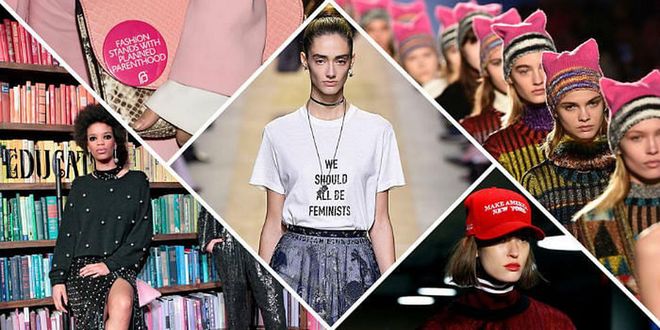
Photo: Getty
Feminism, runway
Immediately following the 2016 election, designers filled runways around the world with political statements. From Planned Parenthood pins at nearly every show and powerful slogan T-shirts at Prabal Gurung and Dior, to a march of pussy hats down the runway at Missoni, and even the casting of the Women's March co-founders at Mara Hoffman—designers didn’t shy away from creating protests of their own. One year later, the political resistance has only heightened and women's rights movements like #MeToo have gained global momentum. But the Fall 2018 runways, from New York to Paris, felt strangely apolitical and unreflective of the world around us.
At New York Fashion Week, there were no pink "Fashion Stands With Planned Parenthood" buttons or blue ACLU ribbons selected by the CFDA as an official cause, and out of 60 major fashion shows, only seven incorporated politics into their clothes, set design, or inspiration. Last year that number was closer to 25. Which begs the question: was last year's runway activism simply another trend?
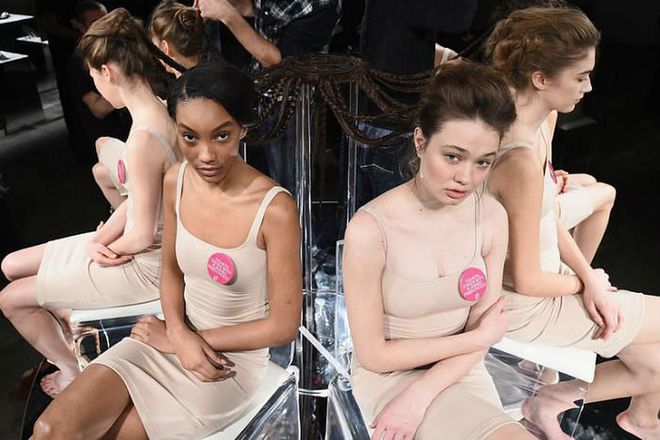
Models wear "Fashion Stands With Planned Parenthood" pins at Chloe Gosselin’s Fall 2017 show. Photo: Getty
Chloe Gosselin
"We decided to focus and deepen our civic commitment with an intensive study that will directly address the gender inequality we see across the industry,” explained Sophie Marx, CFDA’s Director of Marketing and Events, of the absence of political buttons and ribbons at this year’s NYFW. She added: “Moving forward, CFDA’s civic strategy will continue to give our members the opportunity to be a part of meaningful change."
Meaningful change is indeed something that a few designers this year set out to accomplish, most of them touching upon feminism and the current political landscape lightly. Tom Ford sent "Pussy Power" bags and shoes down his runway, Prabal Gurung staged a powerful finale of women linking arms as #MeToo founder Taranna Burke sat front row, while Calvin Klein's show was a dark, apocalyptic-take on the current state of American politics.
Related article: 8 Of The Coolest T-Shirts That Scream Girl Power
Taking things up a notch, Alice + Olivia's Stacey Bendet rewrote the Bill of Rights as "We The Women..." and used it as the backdrop for part of her presentation. The brand’s rewritten amendments called for the right of women to control their own reproductive lives, receive equal pay, be secure from sexual harassment, run for political office without being scrutinized over their gender, along with other demands that felt especially timely amidst the #MeToo and Time’s Up movements. Meanwhile in Paris, Dior staged a full-on 1968 protest down its runway, complete with walls collaged in protest signs and vintage magazine cutouts. But aside from these few moments, most designers opted to keep politics off the runway altogether this season. Perhaps, when the line between cashing in on the resistance and a brand’s genuine political statements has become murky in today’s social media-driven world, that’s a not such a bad thing.
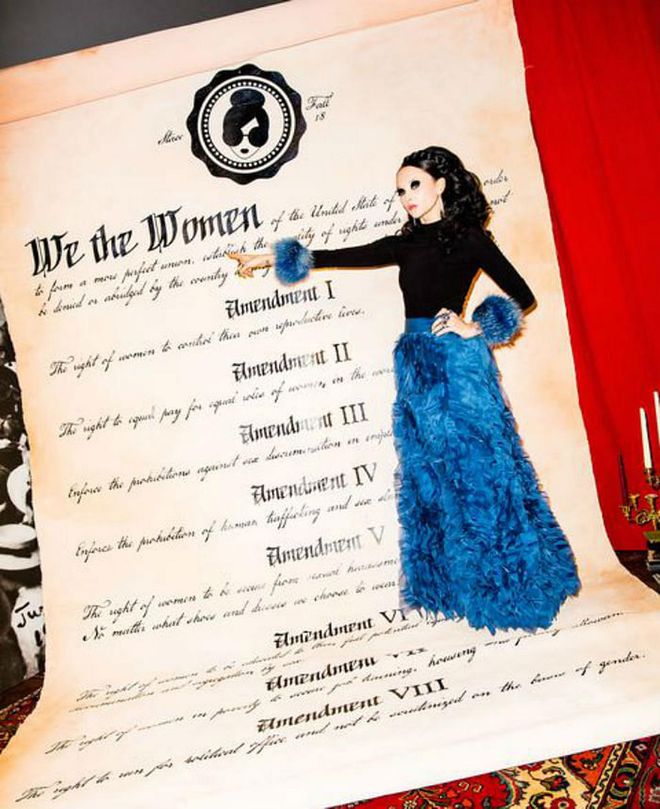
Stacey Bendet with Alice + Olivia’s "We The Women" Bill of Rights. Photo: BFA
Stacey Bendet , Alice + Olivia
Fashion, beauty, and lifestyle companies, which often espouse “empowerment” in new campaigns and email newsletters, quickly realized that feminism could be something for women to buy. But real change does not come in the form of Instagram-friendly T-shirts that donate nothing to a good cause. Similarly, a runway political protest that goes viral may be inspiring, but is the fashion house able to back it up? Does its company pay its female employers equally? Does it offer paid maternity and paternity leave? Does the brand champion diversity and inclusion in hiring, casting, and every day work? And does it genuinely empower those wearing its clothes? Because if not, the brand isn't making any political or feminist statements, it's simply trying to capitalize on a movement. And that is nothing to applaud.
Dior's first female artistic director, Maria Grazia Chiuri, is determined to take advantage of her own position in order to have, as she puts it, "a hand in all the challenges we see as fundamental—from equality within the fashion world to equal rights more generally—and to work together and contribute to the dream of building a fairer world.
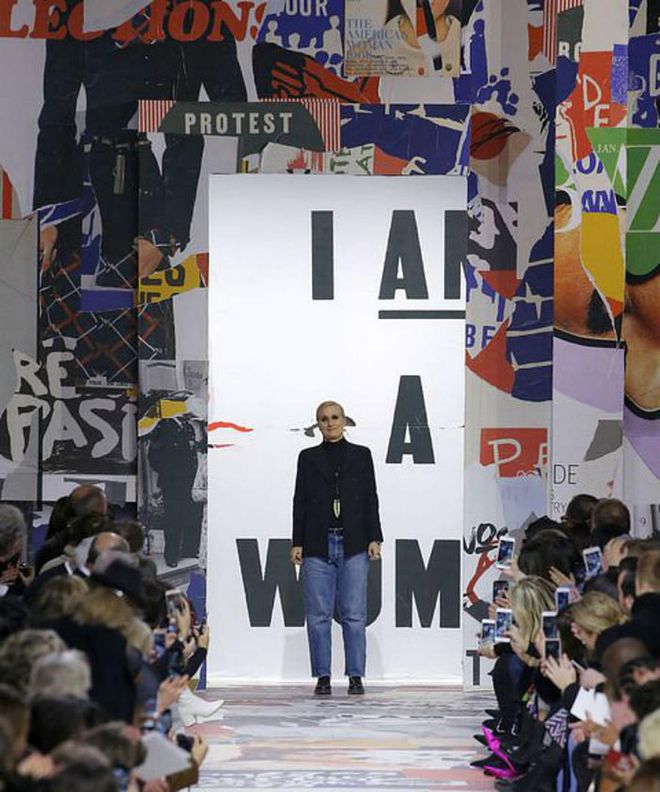
Maria Grazia Chiuri at Dior’s Fall 2018 show.Photo: Getty
Maria Grazia Chiuri
That might mean staging feminist protests on the runway, as she did for Dior's Fall 2018 collection last month, but it also means backing this concept up internally. Dior recently launched Women @ Dior, an international female mentorship program that pairs 100 female employees with 100 female students from fashion, business, and engineering schools across the world. Through the initiative, the fashion house hopes to empower and mentor the industry’s future female leaders.
Related article: Discover The Women Who Inspire Team Bazaar The Most
“I believe that fashion today should take on the responsibility of being activist,” Chiuri added empathically. “At Dior, we are aware—through everything this name has represented in the history of fashion—of the central role we can play today as a gauge of the contemporary."
Alice + Olivia's Stacey Bendet, whose Fall 2018 presentation also incorporated an array of empowering female elements, echoed Chiuri's sentiment that designers should use their voice for social change. "We are living in a time of turmoil and it is important for women to stand up, speak up, and ensure that our rights our protected. Social media has given designers and brands an incredible voice and I believe in this moment it is imperative that we use our platform to stand up for what we believe in."

Jonathan Simkhai’s Fall 2018 collectionPhoto: Getty
Jonathan Simkhai
As demonstrated by Hollywood on the red carpet earlier this year, fashion’s power to make impactful statements transcends well beyond the runway. From actresses opting for an all-black dress code at the Golden Globes to attendees accessorizing with white roses at the Grammys in support of the Time’s Up movement, symbolic fashion has the potential to make just as much of an impact.
Proving the power of such symbolism—that political runway statements don’t always need picket signs or overt feminist imagery—was Jonathan Simkhai. The New York designer, who has utilized T-shirts to advocate for Planned Parenthood in the past, made a subtler statement at his show this season, taking a less literal route by looking to feminist influences of the past, like Gibson Girls and Suffragettes, as major influences for his 2018 collection.
“While this season’s messaging was more subtle, equality for women and the upcoming midterms were at the forefront of my mind," explained Simkhai of the inspiration behind his most recent collection. "Many elements of the collection, like the basque jackets and wool glenplaids, were inspired by women who played a major role in shifting the way women and femininity were perceived socially and politically. Remarkably, we are going through a similar change now and it’s exhilarating to watch the status quo shift in the right direction."
In his show notes, Simkhai included a quote from congresswoman Maxine Waters: “We should have hope because we earned it. We worked for it! It’s ours.” Though there was no outright feminist imagery, the point was made through both the collection and the inspiration behind it. And perhaps more importantly, the designer has taken action behind-the-scenes, most recently by teaming up with Janet Mock for an International Women’s Day event that prompted guests to call their Congressional representatives for support on women’s issues.
So where do designers go from here? Some might argue that fashion—and the runway in particular—has no place in politics. But as Amanda Hallay, head of Fashion History at LIM College and host of The Ultimate Fashion History on Youtube, notes, the industry's political and activist tendencies didn't just start in Donald Trump's America. Fashion has always been a reflector of turbulent political times—from the Zoot Suits of the '40s to London's punk wave in the '70s—however the runway "has historically been slower to respond to politics because, traditionally, runway fashion was the domain of [wealthy] women who often lived lives removed from political tumult."
Of course, in today's world, the runway is no longer reserved solely for the elite class, but instead seen by virtually everyone with access to internet. When you look at times of major political uproar in the past, especially the protests of the 1960s and 1970s, designers didn't really have the opportunity to use runway shows as platforms for social change in an Instagram-free world. Today, for the first time ever, fashion can present more than just next season’s trends on the runway—which is both an opportunity and an obstacle for many brands.
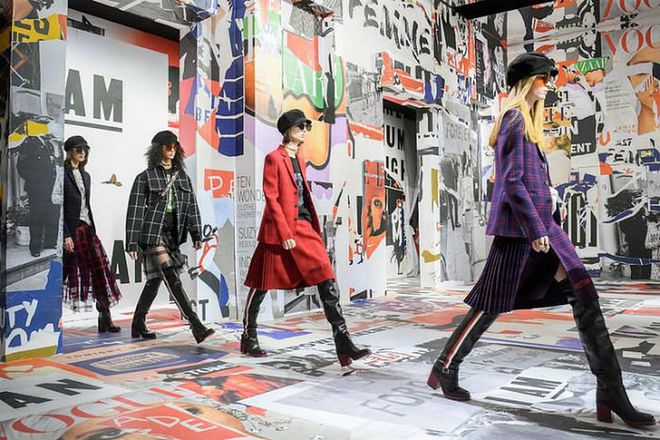
Dior Fall 2018Photo: Getty
Dior Fall 2018
A full-out protest isn't necessary on every runway, but it is becoming increasingly clear that remaining apolitical altogether is no longer an option in the fashion industry. As runways are more visible around the world than ever, why not use that as a way to speak out about—and more importantly, actually support—important issues? Especially when it comes to topics like women's equality, immigration, and LGBT rights—all of which directly impact the fashion industry.
Related article: The Biggest Fashion Moments To Relive From 2017
Sure, a collection of pretty clothing will always be beautiful to look at, but in the current state of world affairs, brands now have an ability to align themselves with the women who are actually wearing their clothes. As Hallay noted, "I doubt Dior was aware that the New Look of 1947, which spoke to a return to femininity in the post-war era and an embrace of excess fabric after many years of rationing, was quite politic; he was naturally, and quite brilliantly, responding to the zeitgeist. Today, however, it is different. Designers can use a collection to deliberately make a political stance."
This article originally appeared on Harper's BAZAAR US.